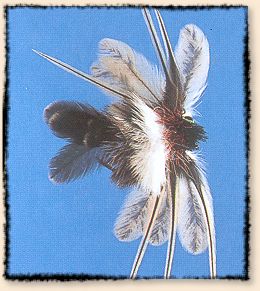|
I haven't tied a fly in many years, but I haven't
lost interest in tying - nor the appreciation for the
talent and creativity which goes into tying.
I was looking for a fly to use in the Old Fly section
and was searching specifically for the Bivisible. You
can read its story in the Old Fly section, but I
mention it because the search took me through several
of our tying and tying reference books. I was amazed
to see so many variations, all called by the same name.
It isn't that I object to variations on any fly, but I
would like the tier to say it's a variation. No, I don't
want nor intend to be the fly police, it just struck me
as odd.
There has to be at least a thousand fly patterns tied
for every insect known to man - and some tied to
represent things which aren't insects at all. You know,
the mice, frogs and I even came across a bird fly!
Seriously, that one is in the FFF Fly Tying Encyclopedia
and it is absolutely fascinating. It is listed under
'Baitfish and Panfish...' and it says: "Application: Cut
off the hook point and see how long the fish will hold
the fly or return to recapture it." Harry Smith is the
creator of this marvel. I'm guessing it was intended
to drive big toothy fish off the edge.
Now I don't feel quite to so bad for casting to the neighbor's
cat. Well I wasn't actually, I was trying out a new rod and
the light seemed to catch on the leader. It 'sparkled' enough
to entice the cat to stalk it. There was no hook attached,
just a bit of fuzzy yarn so it seemed sporting enough. Once the
cat saw it, there was no turning back. It would follow it
time after time. I got bored before the cat did.
Another search a couple of weeks ago for a Water Boatman
(I ended up using Phil Rowley's Water Floatman) did turn
up an unusual material on the back of another Water Boatman.
A woman's artificial fingernail was cut to size and painted
to match the local insect. One more reason for guys to be
shopping in the Women's Cosmetic Departments. Ya, like you
needed another excuse.
At the recent Idaho Fish-In a couple of the fellows
brought a variety of wild-game hair to share with the
group. There was various deer, elk, antelope and even
caribou. I hope over the winter we'll hear about some
of the flies tied with it.
For that matter, we are always looking for flies for the
Fly of the Week section here on FAOL. These don't
have to be the most difficult or obscure flies - what we
are looking for are flies that work for you in your region.
If they work for you, they should work for others. Sometimes
there is a material others may not have found - or a tying
method which is especially effective. They can be for
trout, bass, bluegills, toothy critters or saltwater. Love
to see them all! Contact me if you would like to do one.
Just in case you are still wondering about Harry Smith's
Bird Fly, here it is:

Hook: TMC 8089, #2.
Thread: DaiRiki 5x tippet.
Underbody: Spun and trimmed deer hair.
Body: Chickabou or marabou, color of choice.
Wing and tail: Saddle hackle, any color.
Legs: Rubber leg material.
Hanger: Piano wire.
Head: Spun and trimmed deer hair.
Eyes: Green with black pupils.
I think the neatest thing about fly tying is the
ability to use your creativity to see and translate
the vision into a fly which works. When I look at
the flies in the Atlantic Tying section I can almost
see some of those flies moving underwater. . .and
see the fish follow them.
Although there are those who tie the ultra-realistic
flies I wonder if giving the time a fish has to inspect
the fly and either 'take' or refuse it which is more
effective, the impressionistic or the exact match?
What do you think?
~ The LadyFisher

If you would like to comment on this or any other article please feel free to
post your views on the FAOL Bulletin Board!
|





